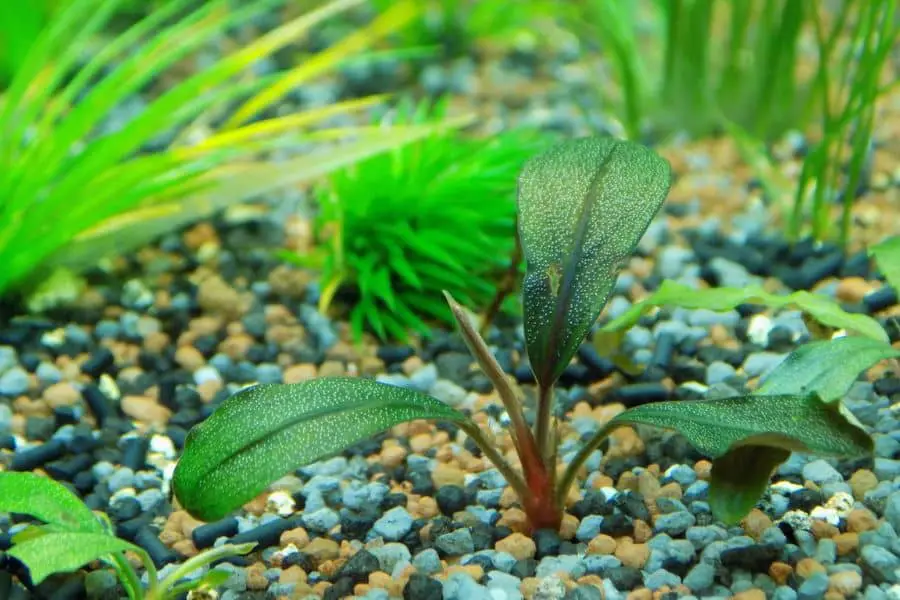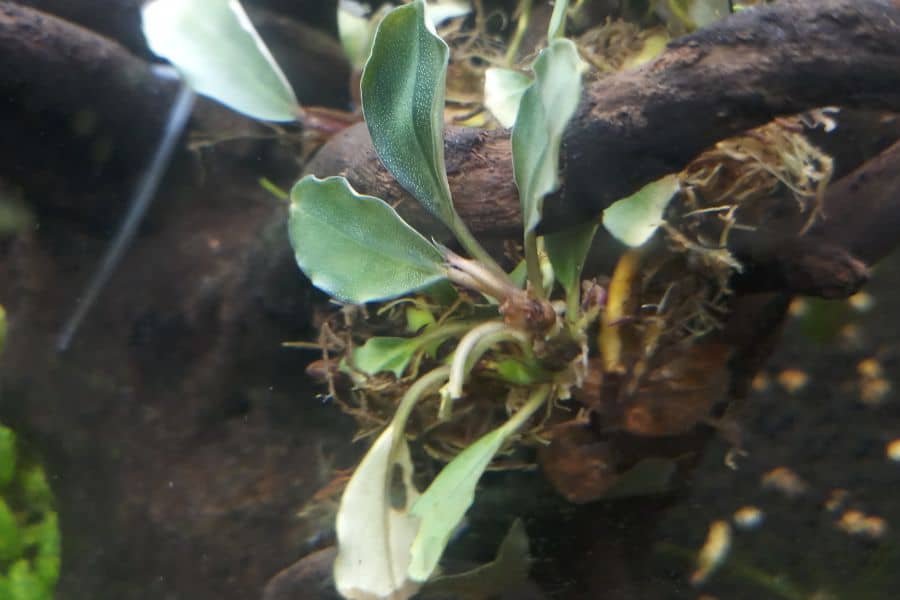Bucephalandra is one of the hardest plants in the aquarium world. There are a lot of different bucephalandra species that have their own distinctive coloration and looks. This plant is widely used in any aquarium setup since it is very versatile and can grow almost everywhere.
Although in some places, bucephalandra can be a bit on the high end, when it comes to price. Did you know, that you can actually make a bucephalandra plant farm in your home with minimal care? Read this article and find out how!

The Differences Between Submerged and Emersed Plants
Jump To
Every plant has different biological capabilities. Some species can tolerate a wide range of water parameters (temperature, hardness, pH), and others are very picky and can die off quickly. In most cases, there can be a lot of reasons why your aquarium plants are dying, so it is best to use hardy plants unless you have more experience. Bucephalandra is one of those plants that have amazing looks and also can almost live in any water conditions, emersed and submerged.
You might be wondering, what is the difference between emersed and submerged growth? To put it simply, some plants have the capability to grow while being partially out of the water (amphibious), and others can’t (growing only fully submerged in water). Emersed plants are more versatile when it comes to survivability and usage in aquascapes. Here is a short list of amphibious aquatic plants:
- Hydrocotyle sp.
- Anubias
- Marsilea hirsuta
- Rotala rotundifolia
- Bucephalandra
- Bacopa Caroliniana
Bucephalandra Species Overview
Over the years, amphibious plants have developed the ability to grow out of the water due to their natural environment. For example, bucephalandra natural habitat is near rivers, ponds, and lakes. The water level can fluctuate a lot of the time, especially when seasons change. These species mostly grow in very shady areas in the wild, like jungle streams, which means they can do relatively well with lower light.
Bucephaladra, or as known in the hobby as “buce”, can grow attached to rocks, driftwood, and decorations, and can also be planted if done correctly. Here are the best water parameters for bucephalandra plant:
- Lightning: Low to medium
- pH: 5 – 8
- Water Hardness: soft – medium
- Water Temperature:
- 22 – 28 C (72 – 84 F)
- Growth Rate: Slow
- CO2: Low
- Planting: Can be attached to decorations, or planted if the rhizome is not covered in substrate
- Height: 2 – 10cm
- Fertilizer: Nutrient-rich substrate or liquid fertilizer for aquatic plants
There are over 200 different species of bucephalandra plant, and most of them have different looks, but all species have the ability to adapt to different water parameters and grow in the vast majority of different conditions.

How to Grow Bucephalandra Emersed
This step-by-step guide is created to show you how much bucephalandra plant is hardy and can pretty much grow in a plastic container with minimal light. This bucephalandra farm is very cheap to make and can help you easily propagate more plants in the future.
Step 1. Get all the required components
This bucephalandra farm is very simple and does not require a lot of different things to work. Mainly, you will need a big clear plastic container with a removable lid and some substrate that is it!
Plastic Container
The reason why you need a clear plastic container is sunlight. Although bucephalandra plants are tough, like all living creatures they need sunlight. If you get a plastic container, that is in some other color or not clear, this plant farm might not work, because your bucephalandra will be having a hard time getting enough sunlight to grow. Your plastic container also needs to have a good lid that shuts your container tight.
To grow bucephalandras, you need a lot of moisture in the container itself, so there can’t be a lot of gaps for ventilation. The container size depends on how many bucephalandra you have and how large they are. For the smallest bucephalandra plants, please get a container that is at least 20cm x 10cm x 10 cm (length x width x height) in size.
Substrate
There are a lot of substrates you can use in this particular setup. It is important, that your substrate would have a lot of nutrients, so you can’t just use sand or rocks. Because your bucephalandra will be growing emersed and mainly out of the water, it does not matter how the substrate will look, because this farm’s main goal is to grow more bucephalandra plants for your future aquariums.
When it comes to the substrate, everything relies on your budget. You can easily use universal plant soil, which is used for outdoor plants, and other vegetation, and is one of the cheapest variants. You can also use special aquarium plant substrate, which is in most cases more expensive. Either way, your plant will be growing in any of these substrates, one condition is that your substrate needs to have a lot of nutrients!
Step 2. Prepare the Setup
To start, fill your container with your desired substrate. Make sure you have at least 4cm of the substrate in your container because your plants will have more depth to root in. Secondly, add some water to your container. Make sure the water temperature is not too cold and not too hot, preferably in the 22 – 28 C (72 – 84 F) range. You should stop adding water to your container when the water level reaches the top of the substrate, you do not need more water, because your plant will be growing emersed. Also, there is no reason to add liquid plant fertilizer, since all of the nutrients your plant will be getting from the substrate. Thirdly, take the lid and puncture 4 holes in it, preferably two on the left side, and two on the right side. These holes are for ventilation purposes.
Step 3. Plant Your Bucephalandra
When you are planting your bucephalandra emersed, make sure you do not put the rhizome part of the plant into the substrate, because it will rot and eventually kill the plant. Gently push the roots of the plant into the substrate and make sure your plant rhizome is just above the substrate. Lastly, place your plant container near your window, and your setup is completely finished.
Step 4. Maintenance
There is very little maintenance you need to do with this setup. Every two days be sure to spray your plants with water, so they stay wet and moisturized. Also, be sure to keep them at room temperature, so that is not too cold and hot. If the water level in the container starts to drop below the substrate line, be sure to add more.
Conclusion on How to Grow Bucephalandra Emersed
This setup is very easy and can help you propagate this amazing bucephalandra plant. Why buy more plants at a pet store if you can grow your own? We believe, that every aquarium keeper should know and have basic experience in plant growth. This little setup will definitely help improve skills when it comes to planting and growing aquatic plants.
Read Next : Will Ammonia Kill Aquarium Plants? ( May Be! )
